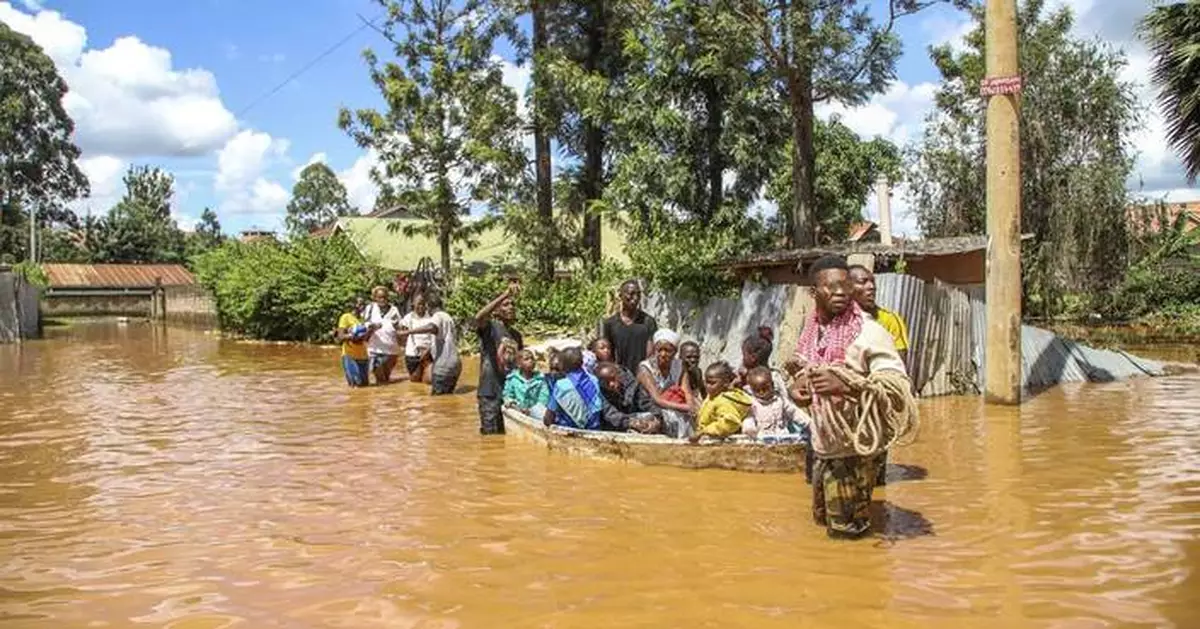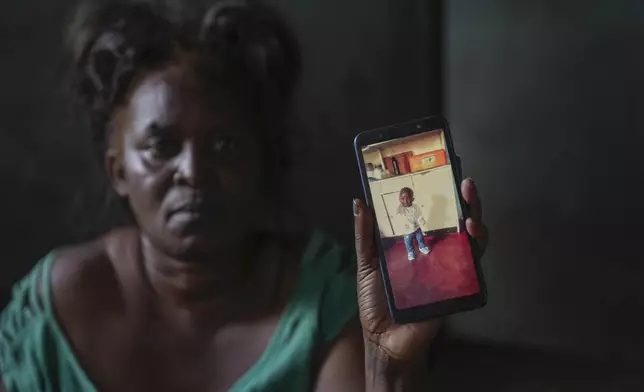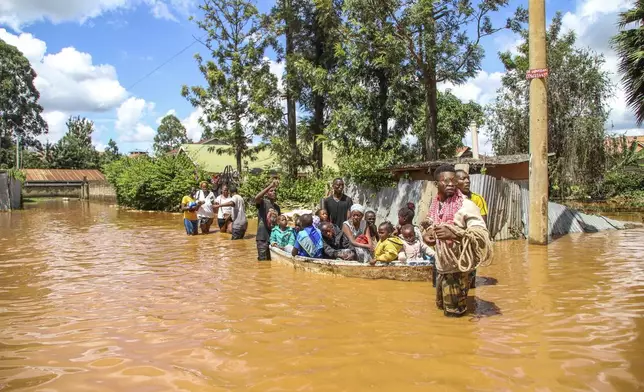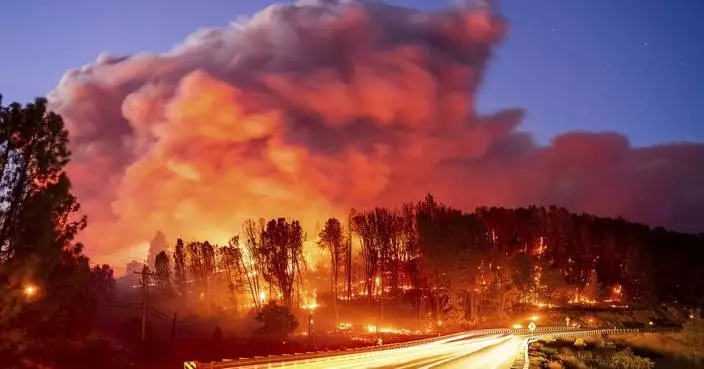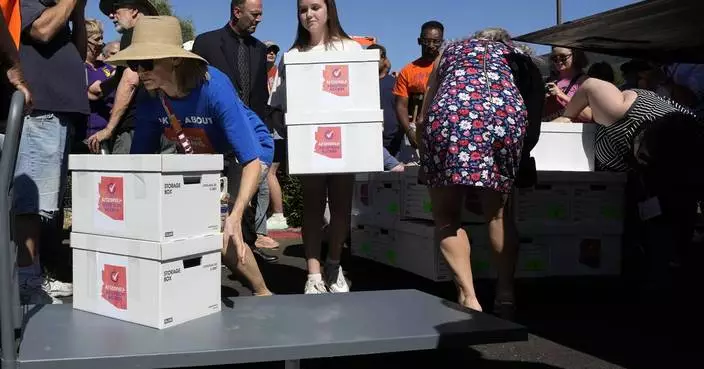LILANDA, Zambia (AP) — Extreme weather events have hit parts of Africa relentlessly in the last three years, with tropical storms, floods and drought causing crises of hunger and displacement. They leave another deadly threat behind them: some of the continent's worst outbreaks of cholera.
In southern and East Africa, more than 6,000 people have died and nearly 350,000 cases have been reported since a series of cholera outbreaks began in late 2021.
Click to Gallery
A picture of Mildred Bandas daughter, survivor of a cholera outbreak, is seen inside their family home in Lilanda, Zambia, Saturday, March 9, 2024. Lilanda, an impoverished township on the edge of the Zambian capital of Lusaka, is a typical cholera hotspot. Stagnant pools of water dot the dirt roads. Clean water is gold dust. Extreme weather events have hit parts of Africa relentlessly in the last three years, with tropical storms, floods and drought causing crises of famine and displacement, and leaving another deadly threat in their aftermath: some of the continent's worst outbreaks of cholera. (AP Photo/Tsvangirayi Mukwazhi)
Mildred Banda holds a phone showing a picture of her one-year-old son who died of Cholera in Lilanda township in Lusaka, Zambia, Saturday, March, 9, 2024. Lilanda, an impoverished township on the edge of the Zambian capital of Lusaka, is a typical cholera hotspot. Stagnant pools of water dot the dirt roads. Clean water is gold dust. Extreme weather events have hit parts of Africa relentlessly in the last three years, with tropical storms, floods and drought causing crises of famine and displacement, and leaving another deadly threat in their aftermath: some of the continent's worst outbreaks of cholera. (AP Photo/Tsvangirayi Mukwazhi)
FILE - Floodwaters are visible in Ombaka Village, Kisumu, Kenya, April 17, 2024. Extreme weather events have hit parts of Africa relentlessly in the last three years, with tropical storms, floods and drought causing crises of hunger and displacement. They leave another deadly threat behind them: some of the continent's worst outbreaks of cholera. In southern and East Africa, more than 6,000 people have died and nearly 350,000 cases have been reported since a series of cholera outbreaks began in late 2021. (AP Photo/Brian Ongoro, File)
FILE - People gather on a bridge after floodwater washed away houses near Nakuru, Kenya, Tuesday, April 30, 2024. Extreme weather events have hit parts of Africa relentlessly in the last three years, with tropical storms, floods and drought causing crises of hunger and displacement. They leave another deadly threat behind them: some of the continent's worst outbreaks of cholera. In southern and East Africa, more than 6,000 people have died and nearly 350,000 cases have been reported since a series of cholera outbreaks began in late 2021. (AP Photo/Brian Inganga, file)
LILANDA, Zambia (AP) — Extreme weather events have hit parts of Africa relentlessly in the last three years, with tropical storms, floods and drought causing crises of hunger and displacement. They leave another deadly threat behind them: some of the continent's worst outbreaks of cholera.
Street vendors sell phone cards under a billboard urging people to protect themselves from Cholera in Lusaka, Zambia, Sunday March, 10 2024. Extreme weather events have hit parts of Africa relentlessly in the last three years, with tropical storms, floods and drought causing crises of famine and displacement, and leaving another deadly threat in their aftermath: some of the continent's worst outbreaks of cholera. (AP Photo/Tsvangirayi Mukwazhi)
Hospital beds stand empty in a ward dedicated to Cholera patients at a government hospital in Lusaka, Zambia, Saturday, March 9, 2024. Lilanda, an impoverished township on the edge of the Zambian capital of Lusaka, is a typical cholera hotspot. Stagnant pools of water dot the dirt roads. Clean water is gold dust. Extreme weather events have hit parts of Africa relentlessly in the last three years, with tropical storms, floods and drought causing crises of famine and displacement, and leaving another deadly threat in their aftermath: some of the continent's worst outbreaks of cholera. (AP Photo/Tsvangirayi Mukwazhi)
A nurse exits from a cholera treatment centre in Lusaka, Zambia, Saturday, March 9, 2024. Lilanda, an impoverished township on the edge of the Zambian capital of Lusaka, is a typical cholera hotspot. Stagnant pools of water dot the dirt roads. Clean water is gold dust. Extreme weather events have hit parts of Africa relentlessly in the last three years, with tropical storms, floods and drought causing crises of famine and displacement, and leaving another deadly threat in their aftermath: some of the continent's worst outbreaks of cholera. (AP Photo/Tsvangirayi Mukwazhi)
A young girl fetches water from a well in Lilanda township in Lusaka, Zambia, Saturday March 9, 2024. Lilanda, an impoverished township on the edge of the Zambian capital of Lusaka, is a typical cholera hotspot. Stagnant pools of water dot the dirt roads. Clean water is gold dust. Extreme weather events have hit parts of Africa relentlessly in the last three years, with tropical storms, floods and drought causing crises of famine and displacement, and leaving another deadly threat in their aftermath: some of the continent's worst outbreaks of cholera. (AP Photo/Tsvangirayi Mukwazhi)
Children fetch water using a wheelbarrow in Lilanda township in Lusaka, Zambia, Saturday March 9, 2024. Lilanda, an impoverished township on the edge of the Zambian capital of Lusaka, is a typical cholera hotspot. Stagnant pools of water dot the dirt roads. Clean water is gold dust. Extreme weather events have hit parts of Africa relentlessly in the last three years, with tropical storms, floods and drought causing crises of famine and displacement, and leaving another deadly threat in their aftermath: some of the continent's worst outbreaks of cholera. (AP Photo/Tsvangirayi Mukwazhi)
Children play near stagnant pools of water in Lilanda township in Lusaka, Zambia, Saturday March 9, 2024. Lilanda, an impoverished township on the edge of the Zambian capital of Lusaka, is a typical cholera hotspot. Stagnant pools of water dot the dirt roads. Clean water is gold dust. Extreme weather events have hit parts of Africa relentlessly in the last three years, with tropical storms, floods and drought causing crises of famine and displacement, and leaving another deadly threat in their aftermath: some of the continent's worst outbreaks of cholera. (AP Photo/Tsvangirayi Mukwazhi)
A picture of Mildred Bandas daughter, survivor of a cholera outbreak, is seen inside their family home in Lilanda, Zambia, Saturday, March 9, 2024. Lilanda, an impoverished township on the edge of the Zambian capital of Lusaka, is a typical cholera hotspot. Stagnant pools of water dot the dirt roads. Clean water is gold dust. Extreme weather events have hit parts of Africa relentlessly in the last three years, with tropical storms, floods and drought causing crises of famine and displacement, and leaving another deadly threat in their aftermath: some of the continent's worst outbreaks of cholera. (AP Photo/Tsvangirayi Mukwazhi)
Mildred Banda holds a phone showing a picture of her one-year-old son who died of Cholera in Lilanda township in Lusaka, Zambia, Saturday, March, 9, 2024. Lilanda, an impoverished township on the edge of the Zambian capital of Lusaka, is a typical cholera hotspot. Stagnant pools of water dot the dirt roads. Clean water is gold dust. Extreme weather events have hit parts of Africa relentlessly in the last three years, with tropical storms, floods and drought causing crises of famine and displacement, and leaving another deadly threat in their aftermath: some of the continent's worst outbreaks of cholera. (AP Photo/Tsvangirayi Mukwazhi)
FILE - Floodwaters are visible in Ombaka Village, Kisumu, Kenya, April 17, 2024. Extreme weather events have hit parts of Africa relentlessly in the last three years, with tropical storms, floods and drought causing crises of hunger and displacement. They leave another deadly threat behind them: some of the continent's worst outbreaks of cholera. In southern and East Africa, more than 6,000 people have died and nearly 350,000 cases have been reported since a series of cholera outbreaks began in late 2021. (AP Photo/Brian Ongoro, File)
FILE - People gather on a bridge after floodwater washed away houses near Nakuru, Kenya, Tuesday, April 30, 2024. Extreme weather events have hit parts of Africa relentlessly in the last three years, with tropical storms, floods and drought causing crises of hunger and displacement. They leave another deadly threat behind them: some of the continent's worst outbreaks of cholera. In southern and East Africa, more than 6,000 people have died and nearly 350,000 cases have been reported since a series of cholera outbreaks began in late 2021. (AP Photo/Brian Inganga, file)
FILE - A family uses a boat after fleeing floodwaters that wreaked havoc in the Githurai area of Nairobi, Kenya, April 24, 2024. Extreme weather events have hit parts of Africa relentlessly in the last three years, with tropical storms, floods and drought causing crises of hunger and displacement. They leave another deadly threat behind them: some of the continent's worst outbreaks of cholera. In southern and East Africa, more than 6,000 people have died and nearly 350,000 cases have been reported since a series of cholera outbreaks began in late 2021. (AP Photo/Patrick Ngugi, File)
Malawi and Zambia have had their worst outbreaks on record. Zimbabwe has had multiple waves. Mozambique, Kenya, Ethiopia and Somalia also have been badly affected.
All have experienced floods or drought — in some cases, both — and health authorities, scientists and aid agencies say the unprecedented surge of the water-borne bacterial infection in Africa is the newest example of how extreme weather is playing a role in driving disease outbreaks.
“The outbreaks are getting much larger because the extreme climate events are getting much more common," said Tulio de Oliveira, a South Africa-based scientist who studies diseases in the developing world.
De Oliveira, who led a team that identified new coronavirus variants during the COVID-19 pandemic, said southern Africa's latest outbreaks can be traced to the cyclones and floods that hit Malawi in late 2021 and early 2022, carrying the cholera bacteria to areas it doesn't normally reach.
Zimbabwe and Zambia have seen cases rise as they wrestle with severe droughts and people rely on less safe sources of water in their desperation like boreholes, shallow wells and rivers, which can all be contaminated. Days after the deadly flooding in Kenya and other parts of East Africa this month, cholera cases appeared.
The World Health Organization calls cholera a disease of poverty, as it thrives where there is poor sanitation and a lack of clean water. Africa has had eight times as many deaths this year as the Middle East, the second-most affected region.
Historically vulnerable, Africa is even more at risk as it faces the worst impacts of climate change as well as the effect of the El Niño weather phenomenon, health experts say.
In what's become a perfect storm, there's also a global shortage of cholera vaccines, which are needed only in poorer countries.
“It doesn’t affect countries with resources,” said Dr. Daniela Garone, the international medical coordinator for Doctors Without Borders, also known by its French acronym MSF. “So, it doesn’t bring the resources.”
Billions of dollars have been invested into other diseases that predominantly affect the world's most vulnerable, like polio and tuberculosis, largely because those diseases are highly contagious and could cause outbreaks even in rich countries. But that's not the case with cholera, where epidemics remain contained.
WHO said this month there is a “critical shortage” of oral cholera vaccines in the global stockpile. Since the start of 2023, 15 countries — the desperate few — have requested a total of 82 million doses to deal with deadly outbreaks while only 46 million doses were available.
There are just 3.2 million doses left, below the target of having at least 5 million in reserve. While there are currently cholera epidemics in the Middle East, the Americas and Southeast Asia, Africa is by far the worst-affected region.
Vaccines alliance GAVI and UNICEF said last month that the approval of a new cholera vaccine would boost stocks. But the result of the shortage has already been measured in deaths.
Lilanda, a township on the edge of the Zambian capital of Lusaka, is a typical cholera hot spot. Stagnant pools of water dot the dirt roads. Clean water is like gold dust. Here, over two awful days in January, Mildred Banda saw her 1-year-old son die from cholera and rushed to save the life of her teenage daughter.
Cholera shouldn't be killing anyone. The disease is easily treated and easily prevented — and the vaccines are relatively simple to produce.
That didn't help Banda's son, Ndanji.
When he fell sick with diarrhea, he was treated with an oral rehydration solution at a clinic and released. He slipped back into dehydration that night at home. Banda feels terrible guilt.
“I should have noticed earlier that my son was not feeling well,” she said, sitting in her tiny concrete house. “I should have acted faster and taken him back to the clinic. I should have taken him back to save his life.”
Because of the vaccine shortage, Zambia couldn’t undertake a preventative vaccination campaign after neighboring Malawi's outbreak. That should have been a warning call, said de Oliveira. Zambia only made an emergency request when its cases started mounting.
The doses that might have saved Ndanji started arriving in mid-January. He died on Jan. 6.
In Zimbabwe, a drought worsened by El Niño has seen cholera take hold in distant rural areas as well as its traditional hot spots of crowded urban neighborhoods.
Abi Kebra Belaye, MSF representative for Zimbabwe, said the southern African nation normally has around 17 hard-hit areas, mostly urban. This year, cholera spread to 62 districts as the struggle to find water heightened the risk.
“This part of Africa is paying the highest price of climate change,” Kebra Belaye said.
Augustine Chonyera, who hails from a cholera-prone part of the capital, Harare, was shocked when he recently visited the sparsely populated rural district of Buhera.
He said he heard grim tales of the impact of the disease: a family losing five members, a husband and wife dying within hours of each other and local businesses using delivery trucks to take the sick to a clinic several kilometers (miles) away.
“It seems now the people in rural areas are in more danger than us. I still wonder how it happened,” Chonyera said.
He said he returned home as soon as he could — after giving a large bottle of treated water he had brought with him to an elderly woman.
Mutsaka reported from Harare, Zimbabwe. Imray reported from Cape Town, South Africa.
The Associated Press receives financial support for global health and development coverage in Africa from the Bill & Melinda Gates Foundation Trust. The AP is solely responsible for all content. Find AP’s standards for working with philanthropies, a list of supporters and funded coverage areas at AP.org.
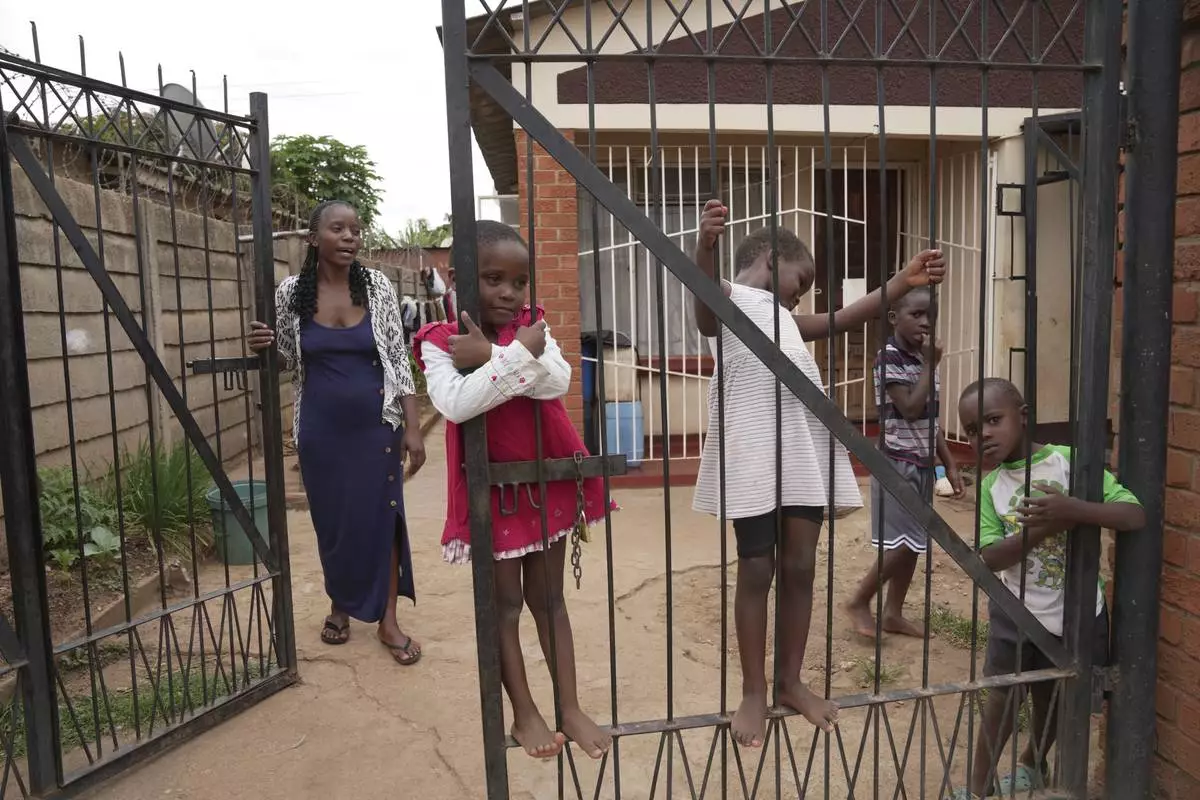
Children survivors of cholera play on a gate on the outskirts of Harare, Zimbabwe, Saturday, March 2, 2024. Extreme weather events have hit parts of Africa relentlessly in the last three years, with tropical storms, floods and drought causing crises of famine and displacement, and leaving another deadly threat in their aftermath: some of the continent's worst outbreaks of cholera. (AP Photo/Tsvangirayi Mukwazhi)
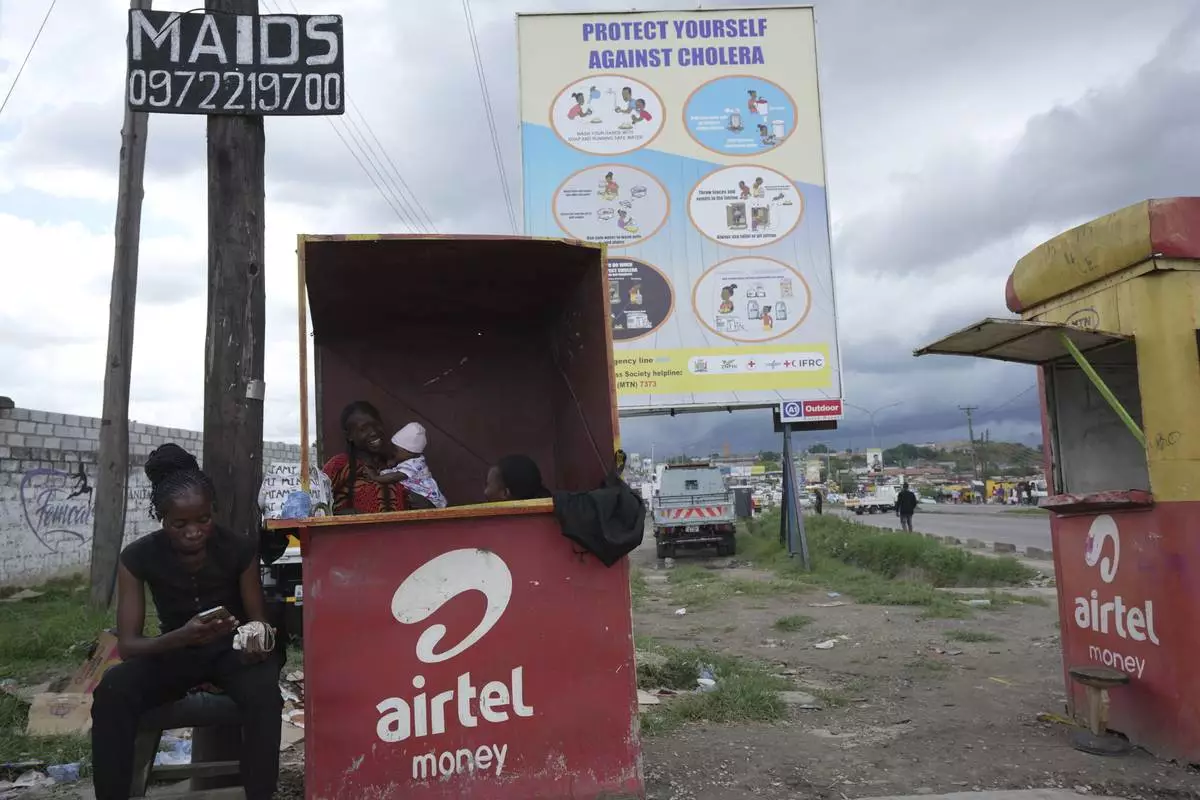
Street vendors sell phone cards under a billboard urging people to protect themselves from Cholera in Lusaka, Zambia, Sunday March, 10 2024. Extreme weather events have hit parts of Africa relentlessly in the last three years, with tropical storms, floods and drought causing crises of famine and displacement, and leaving another deadly threat in their aftermath: some of the continent's worst outbreaks of cholera. (AP Photo/Tsvangirayi Mukwazhi)
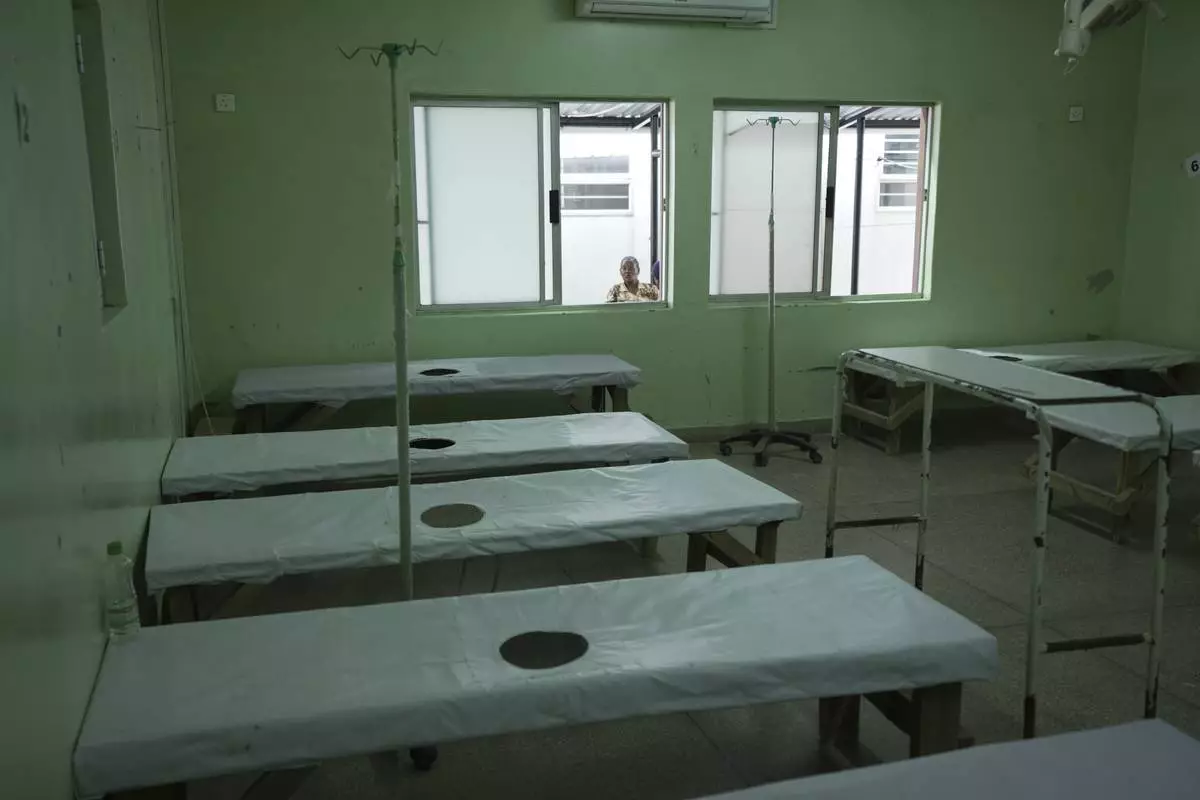
Hospital beds stand empty in a ward dedicated to Cholera patients at a government hospital in Lusaka, Zambia, Saturday, March 9, 2024. Lilanda, an impoverished township on the edge of the Zambian capital of Lusaka, is a typical cholera hotspot. Stagnant pools of water dot the dirt roads. Clean water is gold dust. Extreme weather events have hit parts of Africa relentlessly in the last three years, with tropical storms, floods and drought causing crises of famine and displacement, and leaving another deadly threat in their aftermath: some of the continent's worst outbreaks of cholera. (AP Photo/Tsvangirayi Mukwazhi)
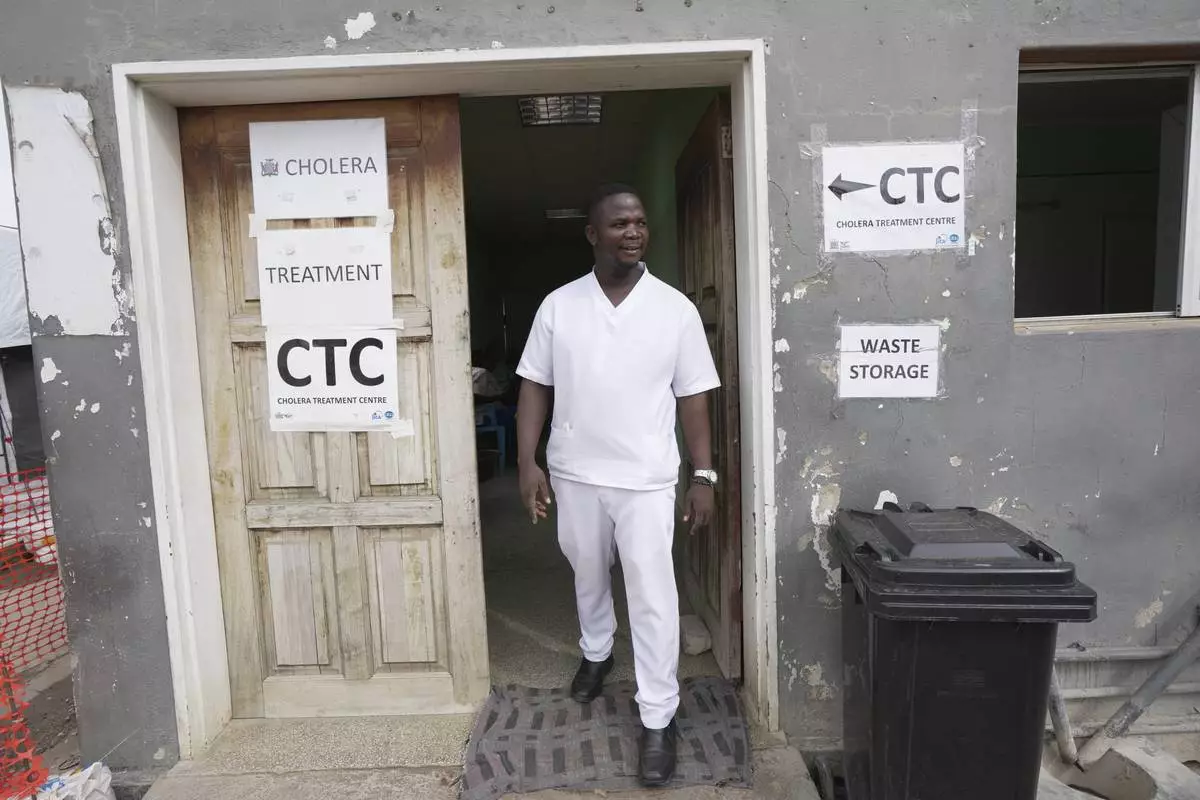
A nurse exits from a cholera treatment centre in Lusaka, Zambia, Saturday, March 9, 2024. Lilanda, an impoverished township on the edge of the Zambian capital of Lusaka, is a typical cholera hotspot. Stagnant pools of water dot the dirt roads. Clean water is gold dust. Extreme weather events have hit parts of Africa relentlessly in the last three years, with tropical storms, floods and drought causing crises of famine and displacement, and leaving another deadly threat in their aftermath: some of the continent's worst outbreaks of cholera. (AP Photo/Tsvangirayi Mukwazhi)
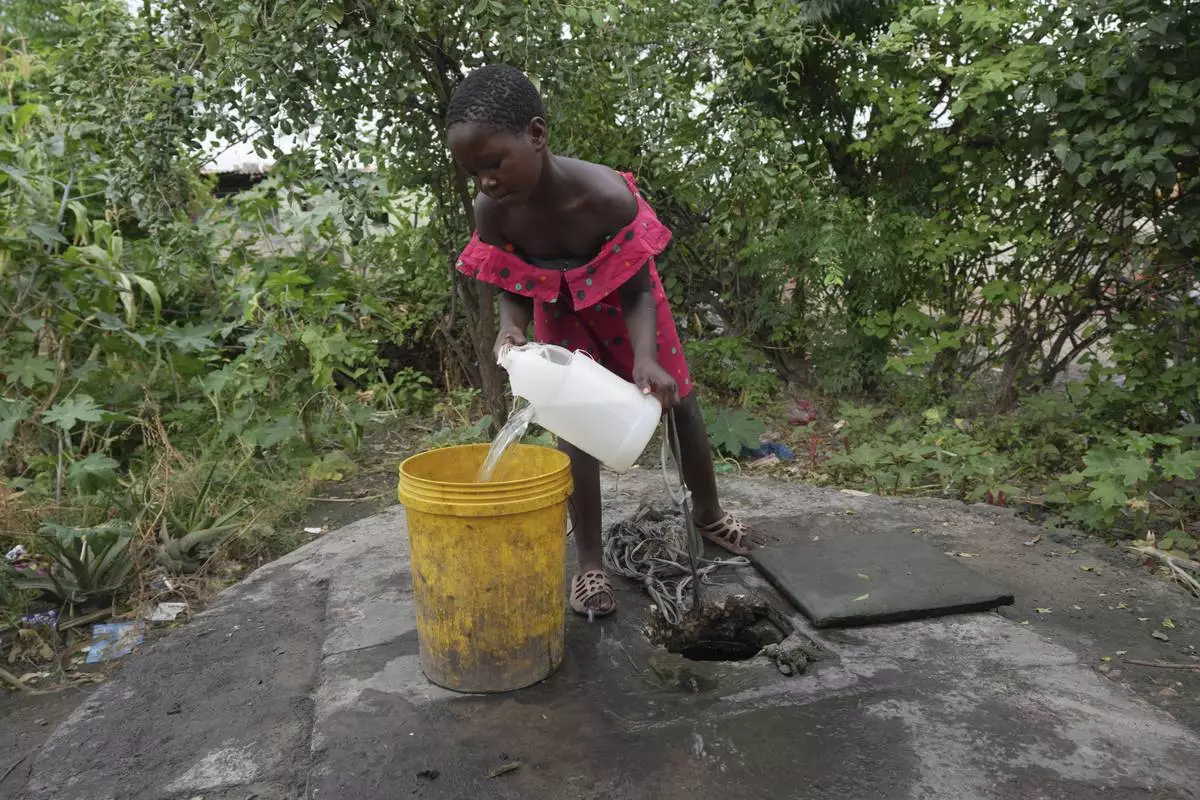
A young girl fetches water from a well in Lilanda township in Lusaka, Zambia, Saturday March 9, 2024. Lilanda, an impoverished township on the edge of the Zambian capital of Lusaka, is a typical cholera hotspot. Stagnant pools of water dot the dirt roads. Clean water is gold dust. Extreme weather events have hit parts of Africa relentlessly in the last three years, with tropical storms, floods and drought causing crises of famine and displacement, and leaving another deadly threat in their aftermath: some of the continent's worst outbreaks of cholera. (AP Photo/Tsvangirayi Mukwazhi)
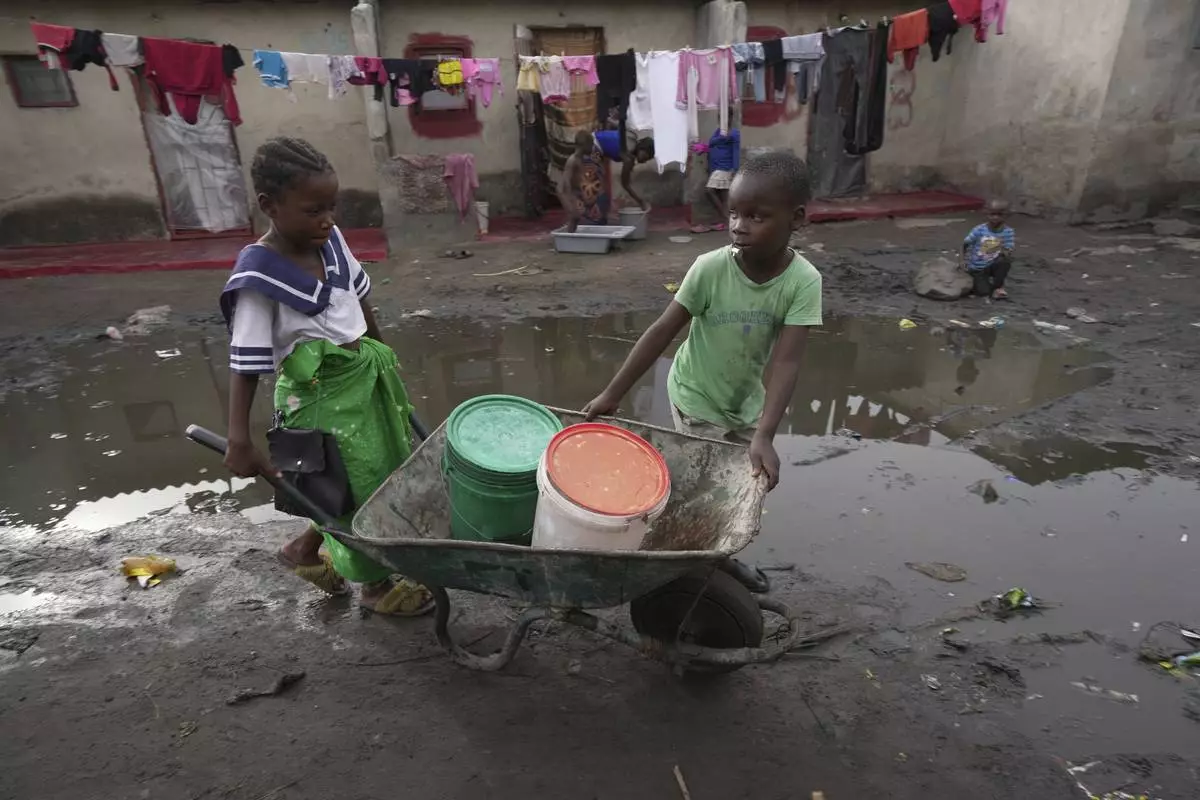
Children fetch water using a wheelbarrow in Lilanda township in Lusaka, Zambia, Saturday March 9, 2024. Lilanda, an impoverished township on the edge of the Zambian capital of Lusaka, is a typical cholera hotspot. Stagnant pools of water dot the dirt roads. Clean water is gold dust. Extreme weather events have hit parts of Africa relentlessly in the last three years, with tropical storms, floods and drought causing crises of famine and displacement, and leaving another deadly threat in their aftermath: some of the continent's worst outbreaks of cholera. (AP Photo/Tsvangirayi Mukwazhi)
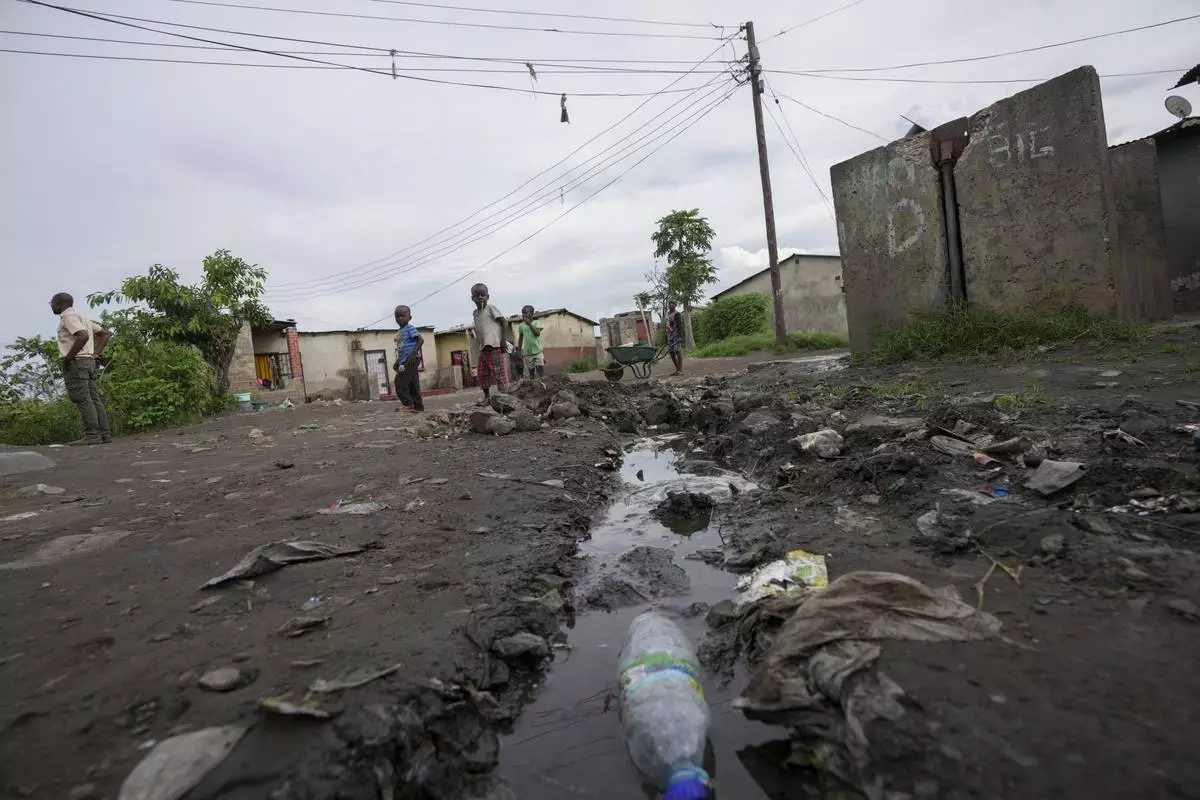
Children play near stagnant pools of water in Lilanda township in Lusaka, Zambia, Saturday March 9, 2024. Lilanda, an impoverished township on the edge of the Zambian capital of Lusaka, is a typical cholera hotspot. Stagnant pools of water dot the dirt roads. Clean water is gold dust. Extreme weather events have hit parts of Africa relentlessly in the last three years, with tropical storms, floods and drought causing crises of famine and displacement, and leaving another deadly threat in their aftermath: some of the continent's worst outbreaks of cholera. (AP Photo/Tsvangirayi Mukwazhi)

A picture of Mildred Bandas daughter, survivor of a cholera outbreak, is seen inside their family home in Lilanda, Zambia, Saturday, March 9, 2024. Lilanda, an impoverished township on the edge of the Zambian capital of Lusaka, is a typical cholera hotspot. Stagnant pools of water dot the dirt roads. Clean water is gold dust. Extreme weather events have hit parts of Africa relentlessly in the last three years, with tropical storms, floods and drought causing crises of famine and displacement, and leaving another deadly threat in their aftermath: some of the continent's worst outbreaks of cholera. (AP Photo/Tsvangirayi Mukwazhi)

Mildred Banda holds a phone showing a picture of her one-year-old son who died of Cholera in Lilanda township in Lusaka, Zambia, Saturday, March, 9, 2024. Lilanda, an impoverished township on the edge of the Zambian capital of Lusaka, is a typical cholera hotspot. Stagnant pools of water dot the dirt roads. Clean water is gold dust. Extreme weather events have hit parts of Africa relentlessly in the last three years, with tropical storms, floods and drought causing crises of famine and displacement, and leaving another deadly threat in their aftermath: some of the continent's worst outbreaks of cholera. (AP Photo/Tsvangirayi Mukwazhi)
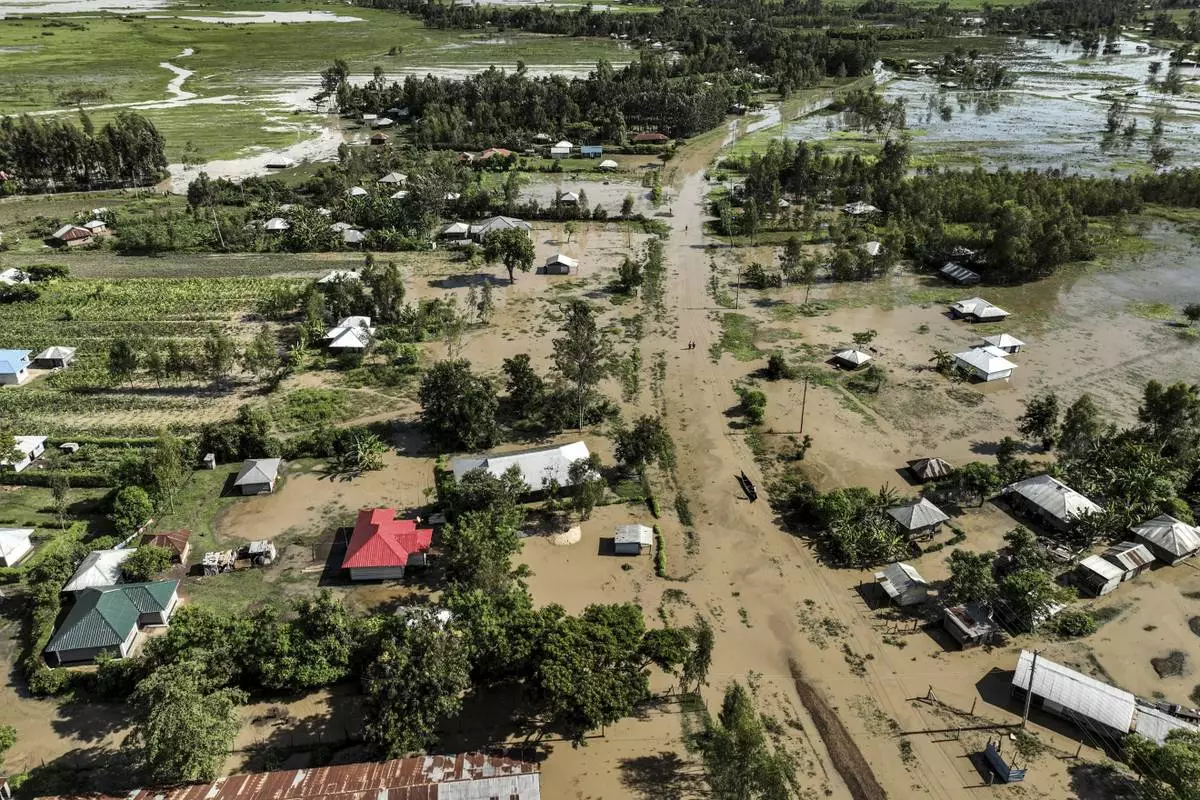
FILE - Floodwaters are visible in Ombaka Village, Kisumu, Kenya, April 17, 2024. Extreme weather events have hit parts of Africa relentlessly in the last three years, with tropical storms, floods and drought causing crises of hunger and displacement. They leave another deadly threat behind them: some of the continent's worst outbreaks of cholera. In southern and East Africa, more than 6,000 people have died and nearly 350,000 cases have been reported since a series of cholera outbreaks began in late 2021. (AP Photo/Brian Ongoro, File)
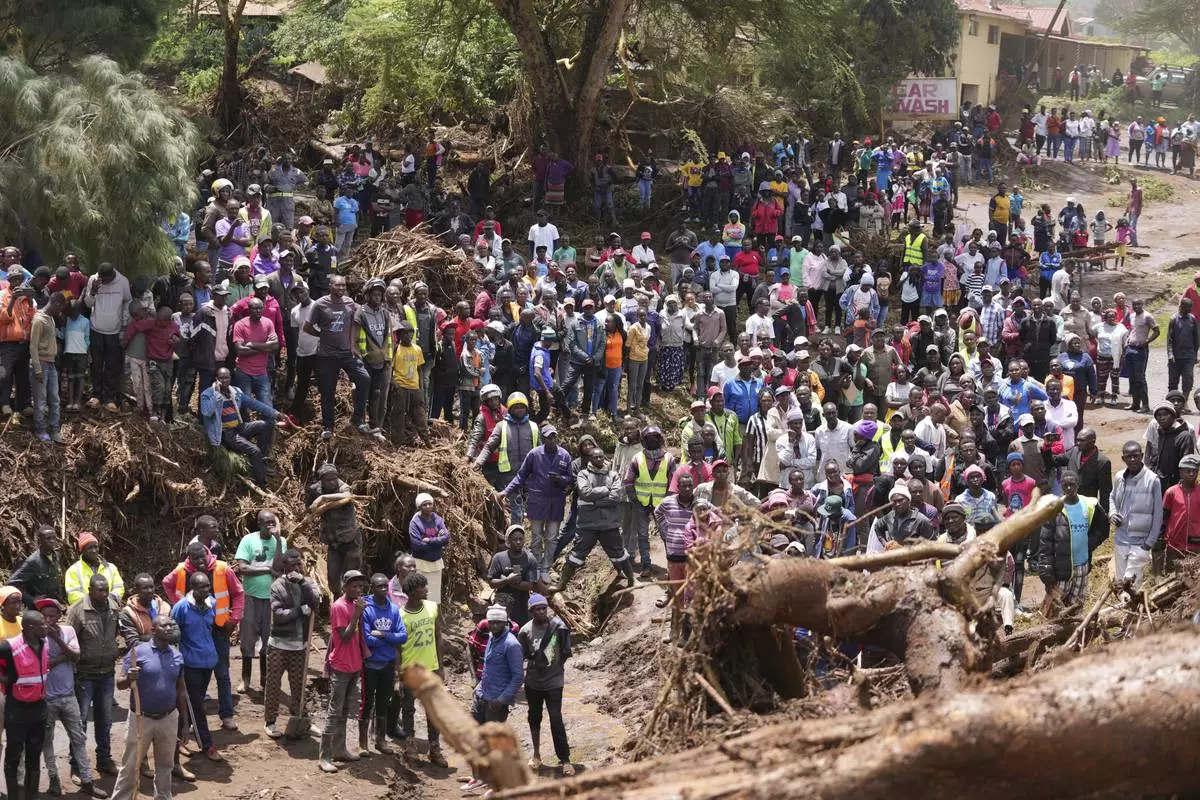
FILE - People gather on a bridge after floodwater washed away houses near Nakuru, Kenya, Tuesday, April 30, 2024. Extreme weather events have hit parts of Africa relentlessly in the last three years, with tropical storms, floods and drought causing crises of hunger and displacement. They leave another deadly threat behind them: some of the continent's worst outbreaks of cholera. In southern and East Africa, more than 6,000 people have died and nearly 350,000 cases have been reported since a series of cholera outbreaks began in late 2021. (AP Photo/Brian Inganga, file)

FILE - A family uses a boat after fleeing floodwaters that wreaked havoc in the Githurai area of Nairobi, Kenya, April 24, 2024. Extreme weather events have hit parts of Africa relentlessly in the last three years, with tropical storms, floods and drought causing crises of hunger and displacement. They leave another deadly threat behind them: some of the continent's worst outbreaks of cholera. In southern and East Africa, more than 6,000 people have died and nearly 350,000 cases have been reported since a series of cholera outbreaks began in late 2021. (AP Photo/Patrick Ngugi, File)
WEST PALM BEACH, Fla. (AP) — Israeli Prime Minister Benjamin Netanyahu worked to mend ties with Republican presidential candidate Donald Trump on Friday and offered measured optimism about progress toward a cease-fire deal for Gaza as he neared the end of a contentious U.S. visit that put on display the growing American divisions over support for the Israeli-Hamas war.
At Trump's Florida Mar-a-Lago estate, where the two men met face-to-face for the first time in nearly four years, Netanyahu told journalists he wanted to see U.S.-mediated talks succeed for a cease-fire and release of hostages.
“I hope so,” Netanyahu said, when reporters asked if his U.S. trip had made progress. While Netanyahu at home is increasingly accused of resisting a deal to end the 9-month-old war to stave off the potential collapse of his far-right government when it ends, he said Friday he was "certainly eager to have one. And we’re working on it.”
As president, Trump went well beyond his predecessors in fulfilling Netanyahu’s top wishes from the United States. Yet relations soured after Netanyahu became one of the first world leaders to congratulate Joe Biden for his 2020 presidential victory, which Trump continues to deny.
The two men now have a strong interest in restoring their relationship, both for the political support their alliance brings and for the luster it gives each with their conservative supporters.
A beaming Trump was waiting for Netanyahu on the stone steps outside his private club and residence in Palm Beach, Florida. He warmly clasped the hands of the Israeli leader.
“We’ve always had a great relationship,” Trump insisted before journalists. Asked as the two sat down in a muraled room for talks if Netanyahu’s trip to Mar-a-Lago was repairing their bond, Trump responded, “It was never bad.”
For both men, Friday’s meeting was aimed at highlighting for their home audiences their depiction of themselves as strong leaders who have gotten big things done on the world stage, and can again.
Netanyahu’s Florida trip followed a fiery address to a joint meeting of Congress on Wednesday that defended his government’s conduct of the war and condemned American protesters galvanized by the killing of more than 39,000 Palestinians in the conflict.
On Thursday, Netanyahu had met in Washington with Biden and Vice President Kamala Harris, who appears on track to becoming the new Democratic presidential nominee after Biden decided to step out of the race. Both pressed the Israeli leader to work quickly to wrap up a deal to bring a cease-fire and release hostages held by Hamas.
Trump’s campaign said he pledged in Friday's meeting to “make every effort to bring peace to the Middle East” and combat antisemitism on college campuses if American voters elect him to the presidency in November.
Netanyahu handed Trump a framed photo that the Israeli leader said showed a child who has been held hostage by Hamas-led militants since the first hours of the war. “We’ll get it taken care of,” Trump assured him.
In a speech later Friday before a group of young Christian conservatives, Trump said he also asked Netanyahu during their meeting how “a Jewish person, or a person that loves Israel” can vote for Democrats.
He also laced into Harris for missing Netanyahu's speech and claimed she “doesn’t like Jewish people” and “doesn’t like Israel." Harris has been married to a Jewish man for a decade.
For Trump, the meeting was a chance to be cast as an ally and statesman, as well as to sharpen efforts by Republicans to portray themselves as the party most loyal to Israel.
Divisions among Americans over U.S. support for Israel’s war against Hamas in Gaza have opened cracks in years of strong bipartisan backing for Israel, the biggest recipient of U.S. aid.
For Netanyahu, repairing relations with Trump is imperative given the prospect that Trump may once again become president of the United States, which is Israel’s vital arms supplier and protector.
One gamble for Netanyahu is whether he could get more of the terms he wants in any deal on a Gaza cease-fire and hostage release, and in his much hoped-for closing of a normalization deal with Saudi Arabia, if he waits out the Biden administration in hopes that Trump wins.
“Benjamin Netanyahu has spent much of his career in the last two decades in tethering himself to the Republican Party,” said Aaron David Miller, a former U.S. diplomat for Arab-Israeli negotiations, now a senior fellow at the Carnegie Endowment for International Peace.
For the next six months, that means “mending ties with an irascible, angry president," Miller said, meaning Trump.
Netanyahu and Trump last met at a September 2020 White House signing ceremony for the signature diplomatic achievement of both men’s political careers. It was an accord brokered by the Trump administration in which the United Arab Emirates and Bahrain agreed to establish normal diplomatic relations with Israel.
For Israel, it amounted to the two countries formally recognizing it for the first time. It was a major step in what Israel hoped would be an easing of tensions and a broadening of economic ties with its Arab neighbors.
In public postings and statements after his break with Netanyahu, Trump portrayed himself as having stuck his neck out for Israel as president, and Netanyahu paying him back with disloyalty.
He also has criticized Netanyahu on other points, faulting him as “not prepared” for the Oct. 7 Hamas attacks that started the war in Gaza, for example.
In his high-profile speech to Congress on Wednesday and again Friday at Mar-a-Lago, Netanyahu poured praise on Trump, calling the regional accords Trump helped broker historic and thanking him “for all the things he did for Israel.”
Netanyahu listed actions by the Trump administration long-sought by Israeli governments — the U.S. officially saying Israel had sovereignty over the Golan Heights, captured from Syria during a 1967 war; a tougher U.S. policy toward Iran; and Trump declaring Jerusalem the capital of Israel, breaking with longstanding U.S. policy that Jerusalem's status should be decided in Israeli-Palestinian negotiations.
“I appreciated that,” Trump told “Fox & Friends” on Thursday, referring to Netanyahu's praise.
Trump has repeatedly urged that Israel with U.S. support “finish the job” in Gaza and destroy Hamas, but he hasn’t elaborated on how.
Natalie Melzer in Tel Aviv, Israel, Adriana Gomez Licon in West Palm Beach, Florida, and Jill Colvin in New York contributed. Knickmeyer reported from Washington. Price reported from New York.
Follow the AP's coverage of the 2024 election at https://apnews.com/hub/election-2024.

Republican presidential candidate former President Donald Trump listens as he meets with Israeli Prime Minister Benjamin Netanyahu at his Mar-a-Lago estate, Friday, July 26, 2024, in Palm Beach, Fla. (AP Photo/Alex Brandon)

Republican presidential candidate former President Donald Trump meets with Israeli Prime Minister Benjamin Netanyahu at his Mar-a-Lago estate, Friday, July 26, 2024, in Palm Beach, Fla. (AP Photo/Alex Brandon)

Republican presidential candidate former President Donald Trump speaks while meeting with Israeli Prime Minister Benjamin Netanyahu at his Mar-a-Lago estate, Friday, July 26, 2024, in Palm Beach, Fla. (AP Photo/Alex Brandon)
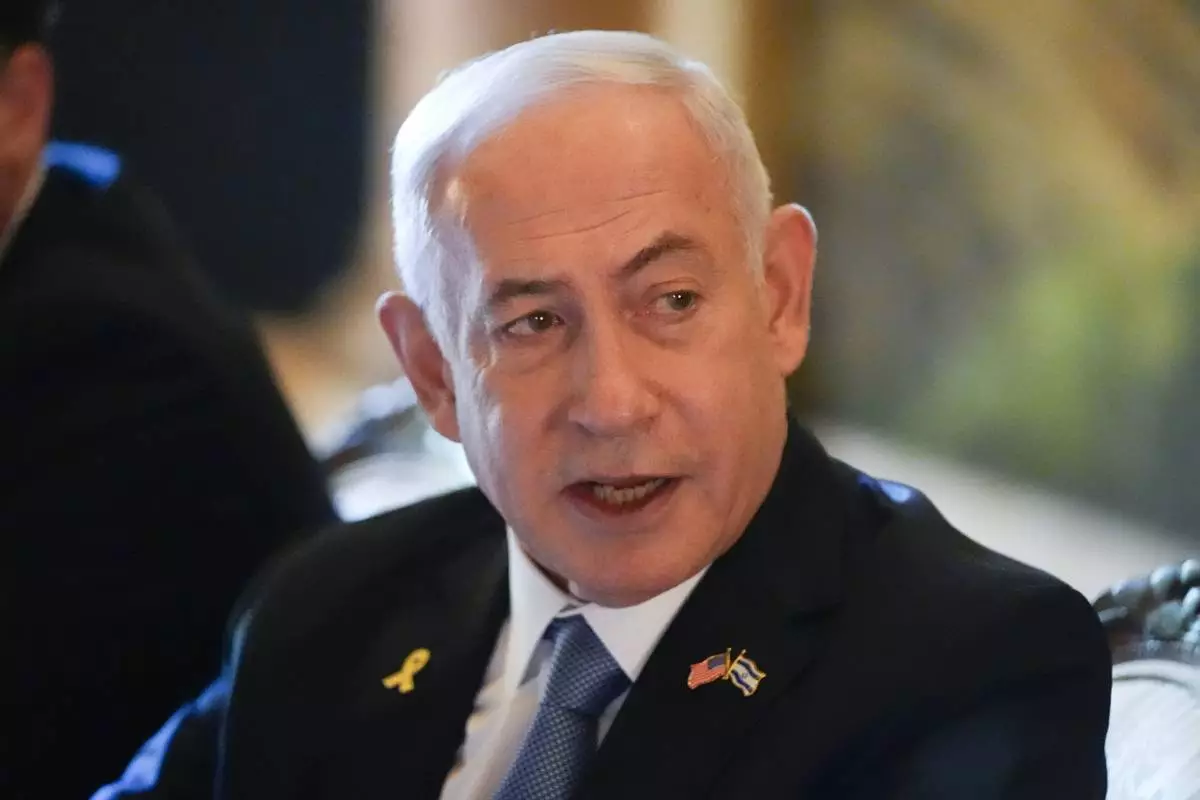
Israeli Prime Minister Benjamin Netanyahu speaks while meeting with Republican presidential candidate former President Donald Trump at his Mar-a-Lago estate, Friday, July 26, 2024, in Palm Beach, Fla. (AP Photo/Alex Brandon)

Republican presidential candidate former President Donald Trump meets with Israeli Prime Minister Benjamin Netanyahu, right, at his Mar-a-Lago estate, Friday, July 26, 2024, in Palm Beach, Fla. (AP Photo/Alex Brandon)

Republican presidential candidate former President Donald Trump meets with Israeli Prime Minister Benjamin Netanyahu at his Mar-a-Lago estate, Friday, July 26, 2024, in Palm Beach, Fla. (AP Photo/Alex Brandon)

Republican presidential candidate former President Donald Trump meets with Israeli Prime Minister Benjamin Netanyahu at his Mar-a-Lago estate, Friday, July 26, 2024, in Palm Beach, Fla. (AP Photo/Alex Brandon)

FILE - President Donald Trump, right, meets with Israeli Prime Minister Benjamin Netanyahu in the Oval Office, Sept. 15, 2020, at the White House in Washington. Trump is due to talk face-to-face with Netanyahu for the first time in nearly four years. The meeting Friday, July 26, 2024, at Mar-a-Lago will mend a break that has lasted since 2021. Trump at the time blasted Netanyahu for being one of the first leaders to congratulate President Joe Biden for his election victory. (AP Photo/Alex Brandon, File)














